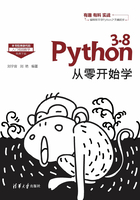
上QQ阅读APP看书,第一时间看更新
5.2.1 dict函数
在Python中,可以用dict()函数,通过其他映射(如其他字典)或键值对建立字典,示例如下:
>>> student=[('name','小智'),('number','001')]
>>> student
[('name', '小智'), ('number', '001')]
>>> type(student)
<class 'list'>
>>> student_info=dict(student)
>>> type(student_info)
<class 'dict'>
>>> print(f'学生信息:{student_info}')
学生信息:{'name': '小智', 'number': '001'}
>>> student_name=student_info['name']
>>> print(f'学生姓名:{student_name}')
学生姓名:小智
>>> student_num=student_info['number'] #从字典中轻松获取学生序号
>>> print(f'学生序号:{student_num}')
学生学号:001
由输出结果可以看到,可以使用dict()函数将序列转换为字典。并且字典的操作很简单,5.1节中期望的功能也很容易实现。
dict函数可以通过关键字参数的形式创建字典,示例如下:
>>> student_info=dict(name='小智',number='001')
>>> print(f'学生信息:{student_info}')
学生信息:{'name': '小智', 'number': '001'}
由输出结果可以看到,通过关键字参数的形式创建了字典。
需要补充一点:字典是无序的,就是不能通过索引下标的方式从字典中获取元素,例如:
>>> student_info=dict(name='小智',number='001') >>> student_info[1] Traceback (most recent call last): File "<pyshell#139>", line 1, in <module> student_info[1] KeyError: 1
由输出结果可以看到,在字典中,不能直接使用索引下标的方式(类似列表)取得字典中的元素,这是因为字典是无序的。
通过关键字创建字典是dict()函数非常有用的一个功能,应用非常便捷,在实际项目应用中,可以多加使用。